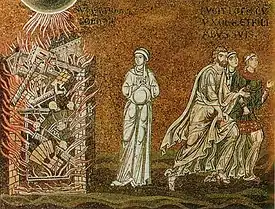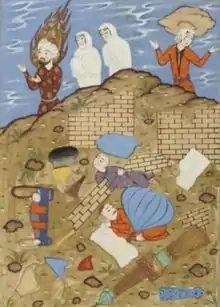Lot's wife
In the Bible, Lot's wife is a figure first mentioned in Genesis 19. The Book of Genesis describes how she became a pillar of salt after she looked back at Sodom. She is not named in the Bible but is called "Ado" or "Edith" in some Jewish traditions. She is also referred to in the deuterocanonical books at Wisdom 10:7 and the New Testament at Luke 17:32. Islamic accounts also talk about the wife of Prophet Lut (Lot) when mentioning 'People of Lut'.
| Lot's wife | |
|---|---|
 | |
| In-universe information | |
| Alias | Ado |
| Spouse | Lot |
| Children | 2 daughters |
| Relatives | Haran (father-in-law) Milcah (sister-in-law) Iscah (sister-in-law) Nahor (uncle-in-law) Abraham (uncle-in-law) Sarah (aunt-in-law) |
| Birth place | Ur Kaśdim |
| Death place | Sodom |
Genesis narrative
The story of Lot's wife begins in Genesis 19 after two angels arrived in Sodom at eventide and were invited to spend the night at Lot's home. The men of Sodom were exceedingly wicked and prompted Lot to offer up these men/angels; instead, Lot offered up his two daughters but they refused. As dawn was breaking, Lot's visiting angels urged him to get his family and flee, so as to avoid being caught in the impending disaster for the iniquity of the city. The command was given, "Flee for your life! Do not look behind you, nor stop anywhere in the Plain; flee to the hills, lest you be swept away."[1]:465 While fleeing, Lot's wife turned to look back, and was turned into a pillar of salt.[1]:466
Composition
The Hebrew verb used for Lot's wife "looking" back is תבט, tāḇeṭ. Her looking back at Sodom differs in word usage from Abraham "looking" שקף, šāqap toward Sodom in (18:16).[2]:49
Pillar of salt

The story appears to be based in part on a folk legend explaining a geographic feature.[3]
A pillar of salt named "Lot's wife" is located near the Dead Sea at Mount Sodom in Israel. The Mishnah states that a blessing should be said at the place where the pillar of salt is.[1]:467 [4] The term "Lots's wife" for such geographical features subsequently entered common parlance, as one of the outcrops comprising Long Ya Men was also nicknamed thus.[5]
The Jewish historian Josephus claimed to have seen the pillar of salt which was Lot's wife.[6] Its existence is also attested to by the early church fathers Clement of Rome and Irenaeus.[7]
Jewish commentaries
In Judaism, one common view of Lot's wife turning to salt was as punishment for disobeying the angels' warning. By looking back at the "evil cities," she betrayed her secret longing for that way of life. She was deemed unworthy to be saved and thus was turned to a pillar of salt.[8]
Another view in the Jewish exegesis of Genesis 19:26, is that when Lot's wife looked back, she turned to a pillar of salt upon the "sight of God," who was descending down to rain destruction upon Sodom and Gomorrah.[1]:467 One reason that is given in the tradition is that she turned back to look in order to see if her daughters, who were married to men of Sodom, were coming or not.[1]:467
Another Jewish legend says that because Lot's wife sinned with salt, she was punished with salt. On the night the two angels visited Lot, he requested that his wife prepare a feast for them. Not having any salt, Lot's wife asked her neighbors for salt, which alerted them to the presence of their guests, resulting in the mob action that endangered Lot's family.[1]:467
Islamic view
Lut (Arabic: لوط) in the Quran is considered to be the same as Lot in the Hebrew Bible. He is considered to be a messenger of God and a prophet of God.[9]
In Islamic tradition, Lot (Lut, Arabic: لوط) lived in Ur and was a nephew of Ibrahim (Abraham). He migrated with Ibrahim to Canaan and was commissioned as a prophet to the cities of Sodom and Gomorrah.[10] He was commanded by Allah to go to the land of Sodom and Gomorrah to preach monotheism and to stop them from their lustful and violent acts. Lut's messages were ignored by the inhabitants, prompting Sodom and Gomorrah's destruction. Though Lut left the city, his wife looked behind and was destroyed.[10]
In the Quran, surah (chapter) 26 Ash-Shu'ara (The Poets) –
So, We saved him and his family, all. Except an old woman among those who remained behind.
Commentary: This was his wife, who was a bad old woman. She stayed behind and was destroyed with whoever else was left. This is similar to what Allah says about them in Surat Al-A`raf and Surat Hud, and in Surat Al-Hijr, where Allah commanded him to take his family at night, except for his wife, and not to turn around when they heard the Sayhah as it came upon his people. So they patiently obeyed the command of Allah and persevered, and Allah sent upon the people a punishment which struck them all, and rained upon them stones of baked clay, piled up.
Other biblical references
Lot's wife is referred to in Wisdom 10:7 and mentioned by Jesus at Luke 17:32[12] in the context of warning his disciples about difficult times in the future when the Son of Man would return; he told them to remember Lot's wife as a warning to not waver at that time.[13]
Popular culture
Lot's wife is the subject of the poem "Lot's Wife" by Anna Akhmatova, which offers a more sympathetic view of Lot's wife's choice to look back. Scott Cairns' poem "The Turning of Lot's Wife" also reimagines the story from a feminist perspective. Lot's wife is mentioned in the opening chapter of Slaughter House Five by Kurt Vonnegut. Vonnegut also offers a sympathetic view and compares her looking back at Sodom to his recalling the fire bombing of Dresden.[14]
Gallery
 A rock formation near the Sanctuary of Agios Lot venerated as Lot's wife as a pillar of salt
A rock formation near the Sanctuary of Agios Lot venerated as Lot's wife as a pillar of salt "Lot's Wife" pillar, Mount Sodom, Israel.
"Lot's Wife" pillar, Mount Sodom, Israel. Salt deposits beside the Dead Sea
Salt deposits beside the Dead Sea The 'Lot's wife' sea-stack, Marsden Bay, South Shields, North East England, United Kingdom located on the North Sea coast
The 'Lot's wife' sea-stack, Marsden Bay, South Shields, North East England, United Kingdom located on the North Sea coast
See also
References
- Schwartz, Howard (2004). Tree of Souls: The Mythology of Judaism. ISBN 9780195358704.
- Hamilton, Victor P. (1995). "looking (back)". The Book of Genesis: Chapters 18-50 (Google eBook) (2nd. ed.). Grand Rapids Michigan: Eerdmans. p. 49. ISBN 9780802823090.
- Hirsch, Emil G.; Seligsohn, M.; Schechter, Solomon; Jacobs, Joseph (1906). "Lot". Jewish Encyclopedia.
- (Talmud B. Ber. 54a)
- National Library Board (2014). Wang Dayuan - Singapore History.
- Josephus. Antiquities of the Jews. Book I. Chapter 11. Verse 4.
- Josephus. Antiquities of the Jews. Book I. Endnote Number 23
- Scharfstein, Sol (2008). Torah and commentary : the five books of Moses : translation, rabbinic and contemporary commentary. Jersey City, NJ: KTAV Publishing. p. 71, #26. ISBN 9781602800205.
- Quran 26:161
- Hasan, Masudul (1987). History of Islam, Volume 1. Islamic Publications. p. 26. Retrieved July 9, 2012. Quote: Lut was a nephew of the Prophet Ibrahim. He migrated with Ibrahim from Iraq to Canaan in Palestine. He was commissioned as a prophet to the cities of Sodom and Gomarrah, situated to the east of the Dead Sea. The people of these cities were guilty of unspeakable crimes. They were addicted to homosexuality and highway robberies. Lut warned the people but they refused to listen to him. He prayed to Allah to punish the people. Lut left the city with his followers at night. As soon as he left, Allah raised a [shower of brim stones?]-end quote, text garbled.
- "Tafsir Ibn Kathir". Quran 26:170–171. qtafsir.com.
- "Lot". Catholic Encyclopedia.
- Carroll, John T. (2012). Luke a commentary (1st ed.). Louisville, Kentucky: Westminster John Knox Press. p. 351. ISBN 9781611642025.
- Slaughter House 5
| Wikimedia Commons has media related to Lot's wife made into a pillar of salt. |
